 Part syncing a 7100 with a Mac.
Part syncing a 7100 with a Mac.
I’m writing this review over a few days, using the 7100v instead of my usual phone. Today, I switched the 7100v on in the morning, received and replied to a few emails and set off for the day.
On the bus, I read the PDA edition of the BBC Web site using the built-in Web browser (more fully covered later). After lunch, I pulled it out of my pocket to check over the mail that had arrived. Imagine my horror when I spotted two huge, yellow lines covering the screen. On scrolling, these lines became more pronounced and seemed to spawn more of themselves, until they covered the whole screen. My first thought was that pixels in the screen were damaged, possibly as a result of me sitting on it, as it had been in my back pocket shortly during my lunch break. I tried switching the handset off and back on again, but the lines didn’t disappear. I was already thinking “Oh no, I’ve broken it” when I had the presence of mind to take the battery out. Miraculously, this solved the problem with the screen, suggesting this problem was possibly a software related one, as opposed to a hardware one. I never did track down what caused it but having bugs like this in released software is not a way to reassure customers that a product is beyond the early-adopter stage and while not a major problem. Occurrences like this one do make you slightly wary of purchasing such a device with your own hard-earned money.
Battery life
My initial experience of the battery life was very poor, with the battery dropping from full to empty within about 8 hours. After a few charging cycles, however, this improved dramatically, and the battery now lasts a good two days under relatively heavy use. This discovery came as a very pleasant surprise to me, as with my usage pattern the only other handset that I had managed to keep alive on a single charge for over a day was an ancient Nokia 6210. The one thing that is bad about the battery on this handset, however, is the time it takes to charge up: It takes around 6 hours (!), an unheard of amount of time in my experience of other handsets. This makes my customary “plug it in for an hour before I go out” habit worthless, as the battery doesn’t even come close to full in that time.
 Screen
Screen
The screen on the 7100 is very impressive in its clarity and brightness – the contrast isn’t bad either. Images viewed on it look very solid, almost as if they are actually colour-printed backlit acetate as opposed to being displayed on an LCD.
The main downfall of the screen is when it is placed in sun-light: The screen is about 5mm below the plastic covering over the screen, and this covering isn’t of particularly high-grade plastic, leading to a badly obscured screen in bright conditions. The cover is also quite reflective, so often you can’t see anything on the screen at all. Indoors however, the screen looks great and everyone I’ve asked about it has been very impressed by it.
Web browsing/access
I have grown accustomed to doing a lot of my Web surfing on the move, or at least not while sitting in front of my computer, as I find it more comfortable that way. To me, it means that the Internet can truly take over from books and newspapers, because you can browse the Net on the sofa, while eating dinner, or anywhere else for that matter and aren’t tied to sitting in a rigid office chair staring at a screen.
As a result of this, the Web browser on the Blackberry was of particular interest to me. RIM seem to have paid particular attention to complying with standards in the design of the Blackberry’s software and this shows in the browser: It supports style sheets and javascript, both features very uncommon for a mobile device. Style sheet support means that, in theory, a Web designer can write one page that will look different when viewed with a small-screen device than when viewed with a full-size computer. This means that it is possible to, for instance, make a small-screen device employ a larger font when rendering a Web page than a computer, to take account of the small screen size. Sadly, sometimes sticking to standards isn’t enough, and this is the case with the Blackberry.
 When Web pages are rendered, there are a lot of unnecessary images which would be represented instead by text. This text is usually shown in the ALT tags of the HTML from which the pages are rendered. On a lot of sites, there are a lot of navigation images, which are not good for render time on a low-powered device like the Blackberry: every time a page is opened containing images, these images are downloaded (this takes a long time with the Internet connection on a 7100v being at dial-up speeds). When downloaded these images are resized individually so as to fit on its screen.
When Web pages are rendered, there are a lot of unnecessary images which would be represented instead by text. This text is usually shown in the ALT tags of the HTML from which the pages are rendered. On a lot of sites, there are a lot of navigation images, which are not good for render time on a low-powered device like the Blackberry: every time a page is opened containing images, these images are downloaded (this takes a long time with the Internet connection on a 7100v being at dial-up speeds). When downloaded these images are resized individually so as to fit on its screen.
Unless the sites that you wish to visit using your Blackberry are graphically very light with little images on them, you may despair of the slow speeds. Other handhelds get around the image problem by simply not displaying all images, only the ones that they think are vital to the site. While this can lead to problems like the right images not being loaded, these problems are uncommon, and the associated speed increase more than makes up for this.
There is a hotkey in between the answer and hang up buttons on the keypad of the Blackberry which opens the Web browser. This may suit some people more than others. Personally, I found it a bit annoying, and it would have been far better to use it as a selection softkey or at least make it configurable.
Part one of this review, looking at how to enter and retrieve information, was published yesterday. Part three will follow.
 Vodafone UK and British Sky Broadcasting (Sky) have announced an agreement to launch Sky Mobile TV, the UK’s first commercially available mobile TV service available on a wide range of handsets, as we first covered back in September.
Vodafone UK and British Sky Broadcasting (Sky) have announced an agreement to launch Sky Mobile TV, the UK’s first commercially available mobile TV service available on a wide range of handsets, as we first covered back in September. The deal looks set to turbo-boost adoption of entertainment and information services to mobile phones, with users able to enjoy TV programmes on the move with access to live breaking news and sports reports from Sky News and Sky Sports News.
The deal looks set to turbo-boost adoption of entertainment and information services to mobile phones, with users able to enjoy TV programmes on the move with access to live breaking news and sports reports from Sky News and Sky Sports News.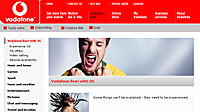 The Sky Mobile TV pack will be provided free of charge (subject to Vodafone customer fair usage policy) until the end of January 2006, with customers being charged £5.00 (~$8.90, €7.38) per month for each of the Sky Mobile TV packs subscribed to thereafter,
The Sky Mobile TV pack will be provided free of charge (subject to Vodafone customer fair usage policy) until the end of January 2006, with customers being charged £5.00 (~$8.90, €7.38) per month for each of the Sky Mobile TV packs subscribed to thereafter, Additional mobile channels are likely to sign up to the Sky Mobile TV service over the coming months.
Additional mobile channels are likely to sign up to the Sky Mobile TV service over the coming months. Vodafone plans to unleash a swarm of new 3G mobile handsets in the run-up to Christmas as the company tries to turbo charge mass market adoption of its third-generation (3G) mobile service.
Vodafone plans to unleash a swarm of new 3G mobile handsets in the run-up to Christmas as the company tries to turbo charge mass market adoption of its third-generation (3G) mobile service.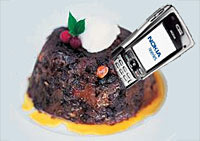 The non-exclusive handsets will include the hugely popular Motorola RAZR V3x phone, the Nokia N70 and 6280, and Samsung’s SGH-Z500V and SGH-Z140V phones.
The non-exclusive handsets will include the hugely popular Motorola RAZR V3x phone, the Nokia N70 and 6280, and Samsung’s SGH-Z500V and SGH-Z140V phones.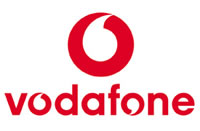 The ability to disconnect from the world has taken a further blow as Vodafone and Microsoft announce a global tied up to offer MSN Messenger IM to Vodafone’s mobile phone customers. People sitting at their MSN Instant Messaging (IM) client on their computers will be able to carry out chats with their Vodafone carrying chums.
The ability to disconnect from the world has taken a further blow as Vodafone and Microsoft announce a global tied up to offer MSN Messenger IM to Vodafone’s mobile phone customers. People sitting at their MSN Instant Messaging (IM) client on their computers will be able to carry out chats with their Vodafone carrying chums.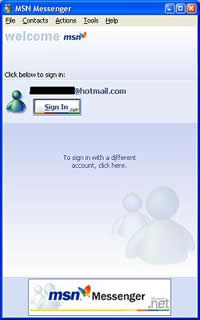 Putting on his best tech-savvy face, Peter Bamford, Chief Marketing Officer for Vodafone glowed, “IM is a growing part of the increasingly important mobile messaging market. By bringing our collective customers together, we’ll deliver more options for staying in touch when messaging. Our agreement will grow IM and SMS, meaning additional revenue for Vodafone.”
Putting on his best tech-savvy face, Peter Bamford, Chief Marketing Officer for Vodafone glowed, “IM is a growing part of the increasingly important mobile messaging market. By bringing our collective customers together, we’ll deliver more options for staying in touch when messaging. Our agreement will grow IM and SMS, meaning additional revenue for Vodafone.” While we didn’t get to any exact figures, we were able to find out the service will be charged on the basis of each message sent. This will cause current IM users to radically change the way they use IM. No more will they be quickly replying with short witticisms, but will need to become more Bard-like in their compositions – if they don’t want to end up with huge bills at the end of the month.
While we didn’t get to any exact figures, we were able to find out the service will be charged on the basis of each message sent. This will cause current IM users to radically change the way they use IM. No more will they be quickly replying with short witticisms, but will need to become more Bard-like in their compositions – if they don’t want to end up with huge bills at the end of the month. Vodafone has made their service more alluring to international business travellers by cutting roaming charges on their 3G data networks.
Vodafone has made their service more alluring to international business travellers by cutting roaming charges on their 3G data networks.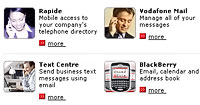 According to analysts Gartner, the new prices demonstrate that operators are currently charging too much; “This is a sign that mobile operators are starting to recognise they charge too much for roaming data services,” they added, as your writer’s head nodded vigorously in agreement (while making snarling noises in the direction of T-Mobile).
According to analysts Gartner, the new prices demonstrate that operators are currently charging too much; “This is a sign that mobile operators are starting to recognise they charge too much for roaming data services,” they added, as your writer’s head nodded vigorously in agreement (while making snarling noises in the direction of T-Mobile). Gartner noted that with Vodafone only selling sold 300,000 3G data cards since launching the 3G data network in January 2004, the company is hoping that the reduced roaming charges will boost this figure.
Gartner noted that with Vodafone only selling sold 300,000 3G data cards since launching the 3G data network in January 2004, the company is hoping that the reduced roaming charges will boost this figure.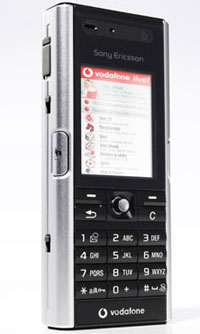 Rather immodestly self-declared as ‘beautifully designed’, Sony Ericsson and Vodafone have announced their new V600i 3G phone.
Rather immodestly self-declared as ‘beautifully designed’, Sony Ericsson and Vodafone have announced their new V600i 3G phone.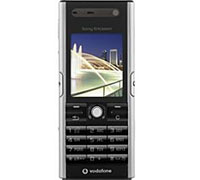 Subscribers can also take advantage of the content streamed from the Vodafone live! site, including live sports and music videos.
Subscribers can also take advantage of the content streamed from the Vodafone live! site, including live sports and music videos. Cutting edge office hipsters keen to perfect that
Cutting edge office hipsters keen to perfect that 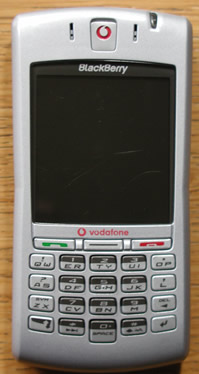 Following on from my recent detailed review of the Vodafone 7100v Blackberry, I thought it would be worth passing on a few tips I’d learnt over the process. One attempting to reassure readers through the scary process of upgrading the operating system on the 7100 Blackberry; the other, a solution for syncing your information with an Apple Mac – not something that is natively supported by RIM or Vodafone.
Following on from my recent detailed review of the Vodafone 7100v Blackberry, I thought it would be worth passing on a few tips I’d learnt over the process. One attempting to reassure readers through the scary process of upgrading the operating system on the 7100 Blackberry; the other, a solution for syncing your information with an Apple Mac – not something that is natively supported by RIM or Vodafone.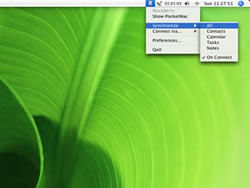 After updating the software, which by the way you need a Windows computer for, I set about syncing the Blackberry with my Mac. My existing phone, the Sony Ericsson P910i, works correctly out of the box with Mac OS X’s iSync application, syncing wirelessly over Bluetooth within a few seconds.
After updating the software, which by the way you need a Windows computer for, I set about syncing the Blackberry with my Mac. My existing phone, the Sony Ericsson P910i, works correctly out of the box with Mac OS X’s iSync application, syncing wirelessly over Bluetooth within a few seconds. Vodafone execs spent the morning cackling wildly to themselves, throwing wads of dollar bills in the air and rolling around silk-covered beds covered in cash as record revenues and profits for its full year results were announced to the world.
Vodafone execs spent the morning cackling wildly to themselves, throwing wads of dollar bills in the air and rolling around silk-covered beds covered in cash as record revenues and profits for its full year results were announced to the world. But in-between triumphant licks of triple-thick Cornish clotted cream, Sarin sounded a cautious note, warning that competition was rising.
But in-between triumphant licks of triple-thick Cornish clotted cream, Sarin sounded a cautious note, warning that competition was rising.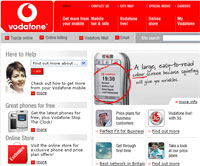 Vodafone performed particularly well in strong markets such as the US and Spain, with revenues growing at more than 20% year on year.
Vodafone performed particularly well in strong markets such as the US and Spain, with revenues growing at more than 20% year on year.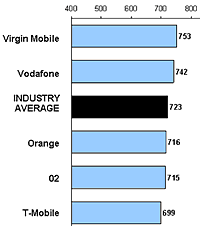 Orange has triumphed in a study rating customer satisfaction among mobile phone contract providers, with Virgin Mobile coming in top in the pre-pay sector, according to the 2005 UK Mobile Telephone Customer Satisfaction Study, run by J.D. Power and Associates.
Orange has triumphed in a study rating customer satisfaction among mobile phone contract providers, with Virgin Mobile coming in top in the pre-pay sector, according to the 2005 UK Mobile Telephone Customer Satisfaction Study, run by J.D. Power and Associates. The authors of the study claim that the results reflect the positive impact of increasing competition and lower tariffs.
The authors of the study claim that the results reflect the positive impact of increasing competition and lower tariffs. The contract segment seemed a well-chuffed bunch too, with satisfaction levels rising to 733 index points from 720 index points in 2004.
The contract segment seemed a well-chuffed bunch too, with satisfaction levels rising to 733 index points from 720 index points in 2004.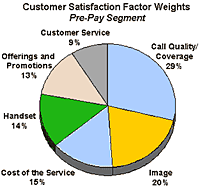 Mobile technology and photo messaging is still a hot potato, with 35 percent of all mobile owners snapping on camera phones and 21 percent sending photos from their mobiles.
Mobile technology and photo messaging is still a hot potato, with 35 percent of all mobile owners snapping on camera phones and 21 percent sending photos from their mobiles.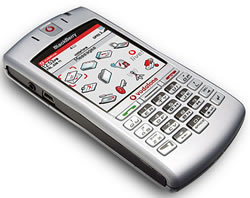 Part
Part 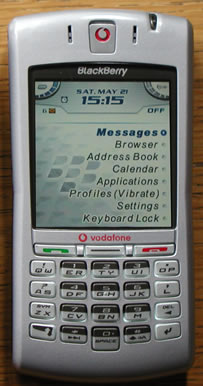 Screen
Screen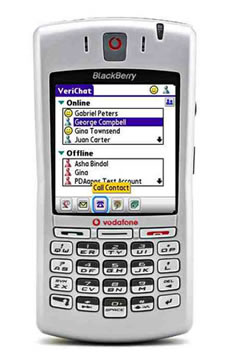 When Web pages are rendered, there are a lot of unnecessary images which would be represented instead by text. This text is usually shown in the ALT tags of the HTML from which the pages are rendered. On a lot of sites, there are a lot of navigation images, which are not good for render time on a low-powered device like the Blackberry: every time a page is opened containing images, these images are downloaded (this takes a long time with the Internet connection on a 7100v being at dial-up speeds). When downloaded these images are resized individually so as to fit on its screen.
When Web pages are rendered, there are a lot of unnecessary images which would be represented instead by text. This text is usually shown in the ALT tags of the HTML from which the pages are rendered. On a lot of sites, there are a lot of navigation images, which are not good for render time on a low-powered device like the Blackberry: every time a page is opened containing images, these images are downloaded (this takes a long time with the Internet connection on a 7100v being at dial-up speeds). When downloaded these images are resized individually so as to fit on its screen.